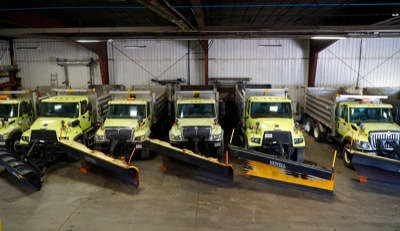Monday, December 11th, 2017
Snowplow drivers ready for winter
By Ed Gebert

Photo by Ed Gebert/The Daily Standard
Auglaize County snow-clearing equipment is lined up and ready to hit the roads in case of snowy or icy weather.
Auglaize and Mercer counties' snowplow drivers are ready for whatever Mother Nature has in store for this winter.
Recent years have not presented the headaches that the more experienced drivers often recall from the winters of 1977, 1978 and 1983.
But each winter presents its own set of driving challenges and drivers are prepared for the worst.
"It can be exciting; it can be very stressful," said Brad Laffin, Mercer County Engineer's Office operations manager, when asked what it's like to drive a plow. "It's a sense of accomplishment, something you do that you are improving, and you can see that improvement basically in front of your eyes."
Laffin has more than 28 years of experience driving a plow, and he still enjoys it.
"Winter's coming, and we feel like we're ready for it," he said. "We have a great group of drivers from a little over a year's worth of experience to 38 years."
Auglaize County Engineer Doug Reinhart has been plowing snow for about 42 years, he said, noting the snow is not the toughest part of plowing.
"The toughest part of West Central Ohio is the wind. It's not the snow. Snow is a major factor, but a 4- to 5-inch snow with no wind is really not a bad situation to plow and clear the snow. The roads are open that afternoon and dry again." Reinhart said.
A 30-mph wind, however, can change conditions quickly.
"We can have two inches of snow with a 30 mph wind and we can fight it all day, and at the end of the evening, the road could be worse than what it was this morning when we took off, and the sun could have been shining all day that day," he said.
Reinhart said another difficult aspect of handling snow events is trying to predict what's in store.
"There have been days we have spent dollars early in the morning knowing this is coming based on (meteorologists') prediction that's never transpired," he said. "It makes us look pretty silly. Or the other way around, we didn't really attack it as hard as we should have. ... So we try to outguess and attack the storm based on what we think is going to transpire that day, and sometimes when that weather changes, we have to make an instantaneous change."
Both men said despite the milder winters in the last few years, snowplow drivers still have plenty of experiences.
Laffin said his most memorable snowstorm involved discovering a buried pickup truck. He couldn't remember the date but said it was a long time ago.
"We had a significant snow, and we had a couple of pieces of large equipment out with a v-plow," he said. "We use them very rarely, but I was going down the center of a road, just opening up a path."
Laffin said he had caught a glimpse of something in the snow and stopped and got out to investigate.
"It was a clearance light on a pickup truck," he said. "The light was still on, but that's how deep the snow was, clean up to the cab."
Reinhart recalled his most memorable experience was Dec. 17, 2016. The problem that day wasn't snow, he said. It was ice.
"Some of the trucks would back up to get some traction under the wheels because it was so icy," he said. "One truck had to back up for two and a half hours from Wapak to St. Marys to get to where he needed to get to."
In Mercer County, 12 full-time routes ranging from 28 to 34 miles make up the 385 miles of roadway cleared with every significant snowfall. In Auglaize County, Reinhart deploys 15 plows on the 350 miles of road.
"If we get in a major storm, then I have two front-end loaders, a grader with a v-plow on the front of it and a skid loader with a snow blower for the subdivisions," he said.
Reinhart said motorists each year must relearn how to drive on snow- and ice-covered roads.
"And I include myself," he said. "Everybody's used to leaving at the last minute and driving 55 or plus to get to work and being able to start and stop at any intersection they want to. After the first snowfall, there are tracks in the side ditches, and we need to be re-trained."
He said drivers must get used to leaving a little earlier and slowing down for a stop much sooner. He also noted that vehicles aren't able to accelerate as quickly, so drivers should make sure the roadway they are about to cross is clear of oncoming traffic before proceeding.
"The biggest thing is that it just takes more time to get from point A to point B, and get there safely," he said.
Laffin reminds drivers to give snowplows plenty of space on the roadways as a plow is larger than most vehicles.
"A lot of our roads are only 18 feet wide, but our snowplows are 12 feet wide," he said. "We angle them as much as we can when we're meeting cars, and we do our absolute best to keep on our side of the road, but depending on conditions that can be tough to do. Please try to give our trucks as much room as possible and as far as following, stay back as far as you can, because a lot of times at that intersection, we might not be going straight through. We may be turning around at that intersection."
He also asks motorists not to get frustrated when encountering a plow.
"They have to wait a little bit, and you're driving slow, but we're doing that for a reason," he said.



